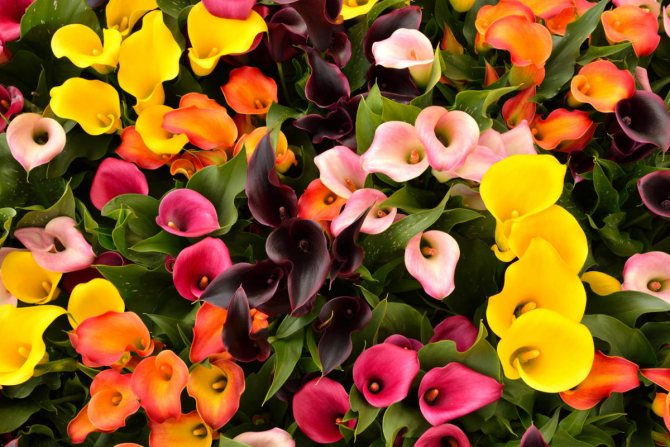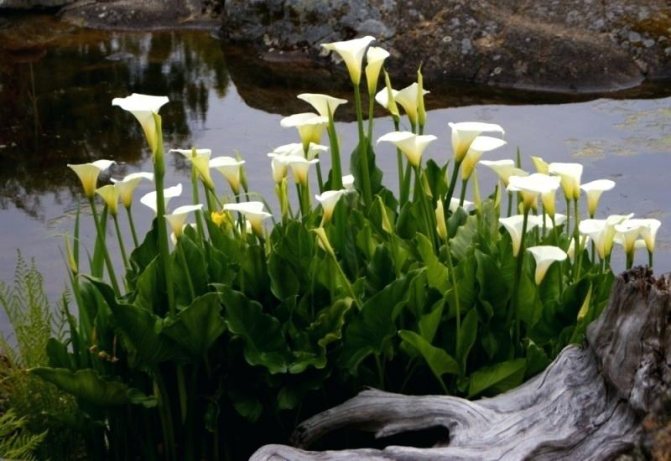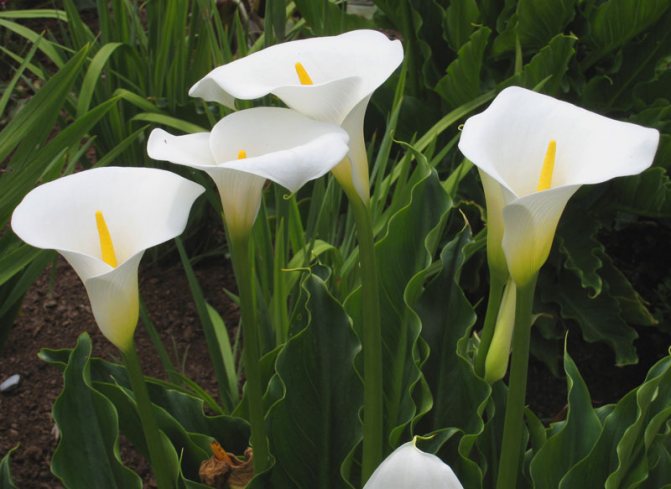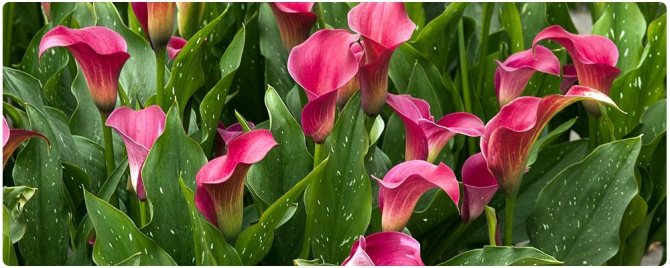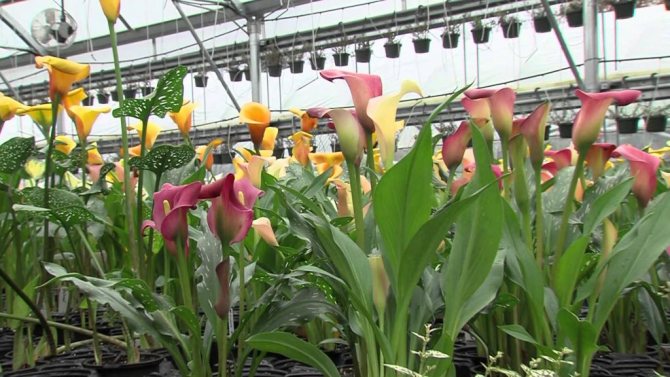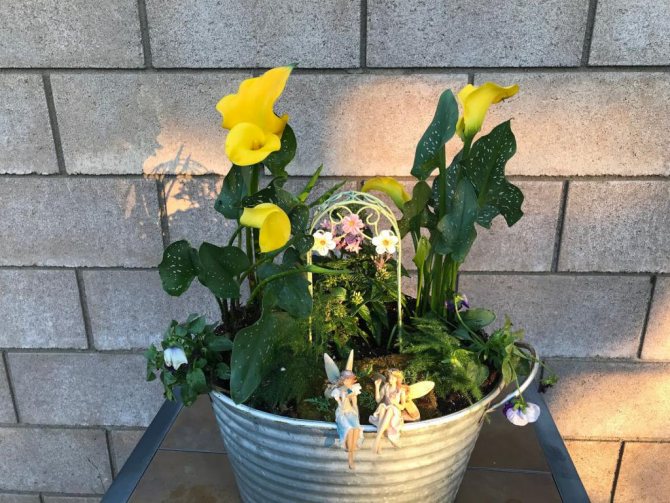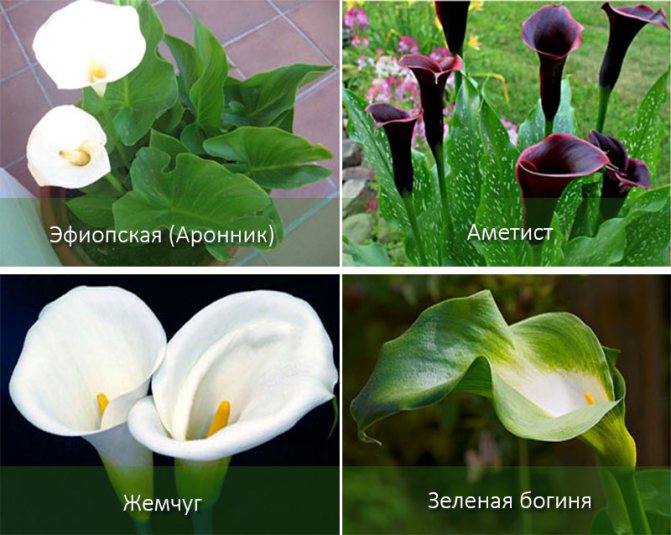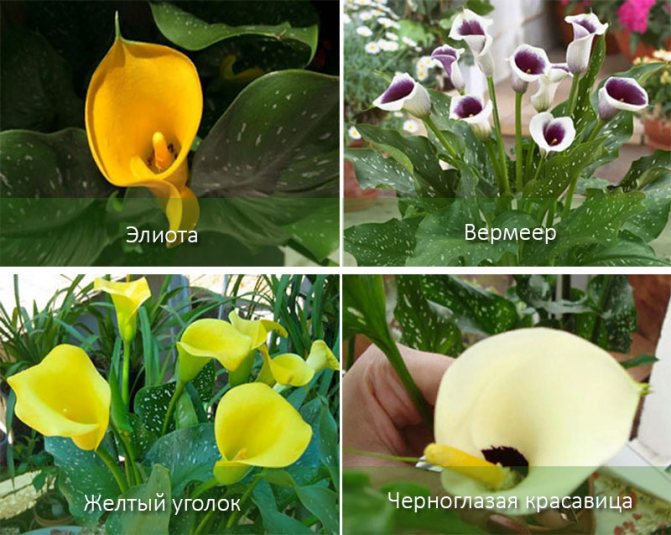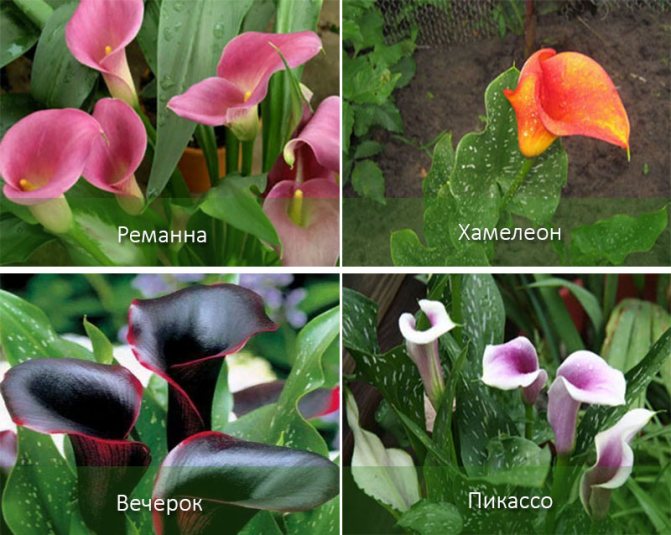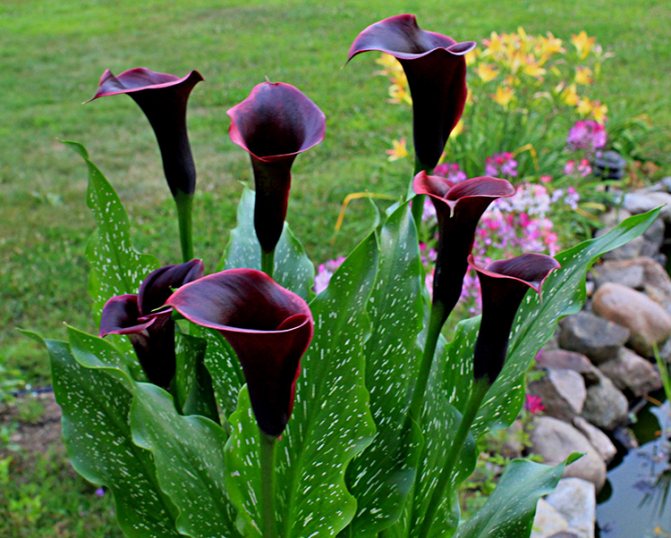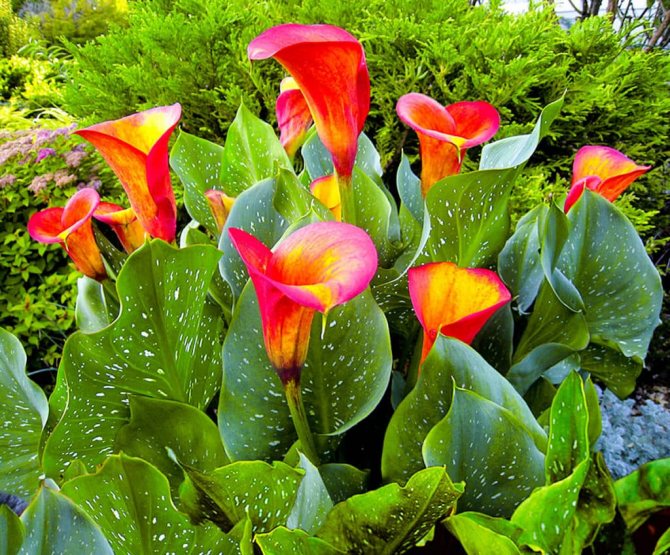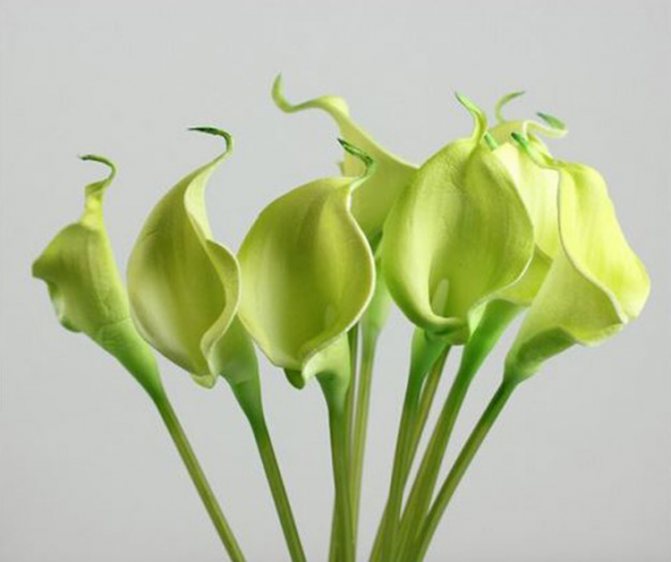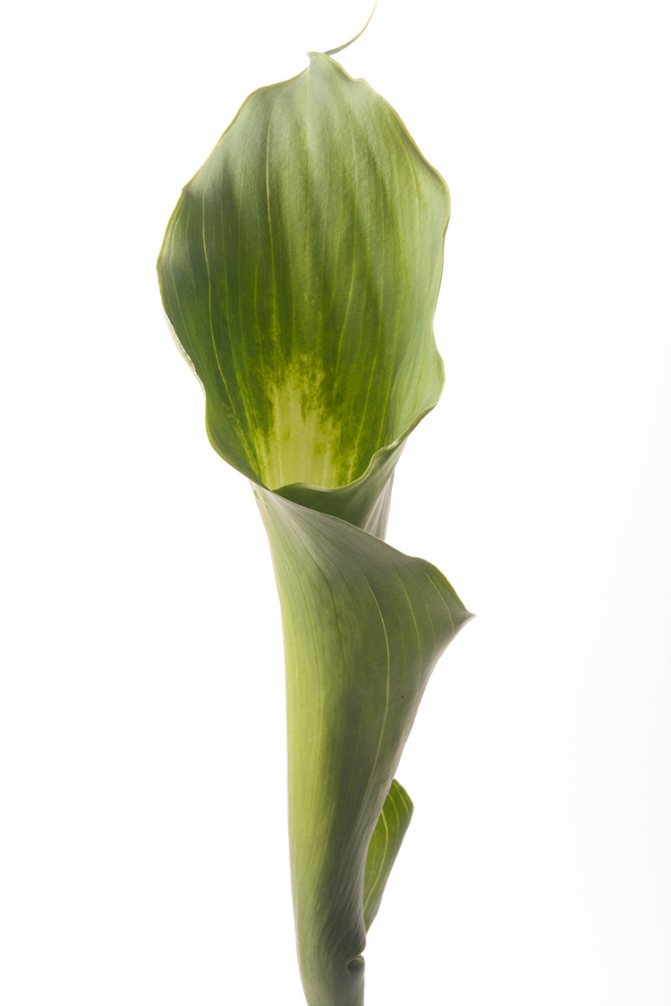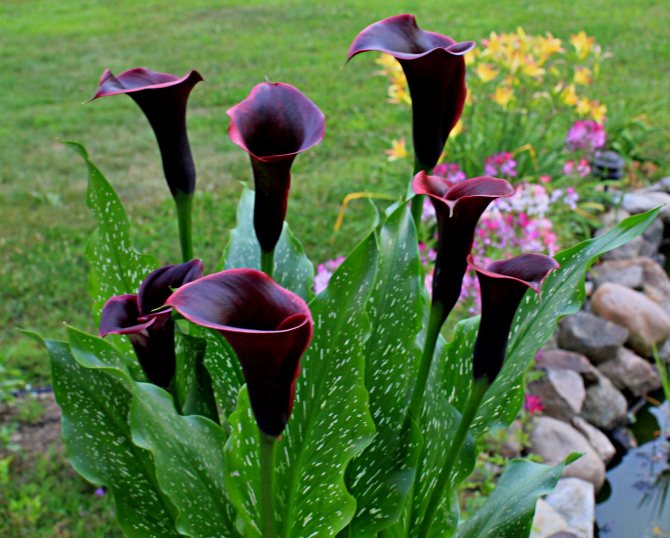Calla is a perennial herb that is very popular in both indoor and garden culture. In areas with warm climates, these flowers can grow in gardens all the time.
In the temperate climate of the middle zone and north, calla lilies are planted in open ground in the spring, and for the winter they are dug up and stored in a closed cool room. Thanks to the large leaves and flowers of an unusual shape, these plants become a real decoration of gardens and parks.
In the article, you will learn everything about planting and caring for garden calla lilies in the open field, as well as how to propagate flowers.
Botanical description
Calla lilies are considered the birthplace of southern Africa, but it is also common in Russia (Siberia, the Far East). Grows in swampy areas or along the shores of small lakes in the form of basal lanceolate green leaves with pointed tips. The plant reaches a length of 20 cm.
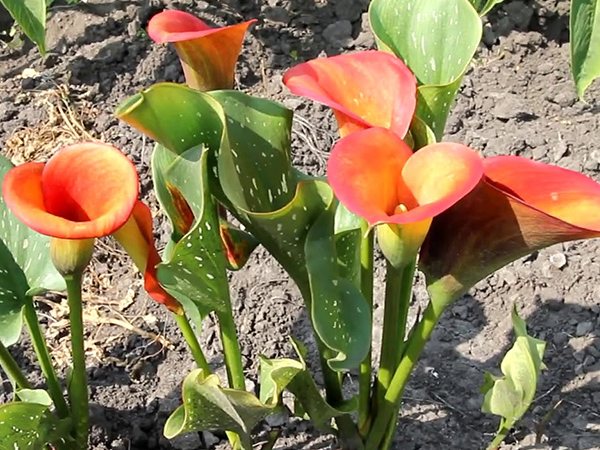
Some varieties have silvery blotches on the surface of the leaf plates. And the leaves themselves are smooth with a slight sheen.
It blooms in late spring - early summer in the form of an inflorescence-cob, surrounded on all sides by a petal (bracts) on a long peduncle. The classic color of calla lilies is white, but varieties with a different color of flowers are also common.
The root system is a rhizome with abundant branching.
Method and place of planting flowers


Calla tubers ready for planting
Planting calla lilies outdoors should be done in warm, well-lit areas that provide the flowers with lots of light and warmth. It is impossible to place them in too dark places, since the abundance of light and warmth reminds thermophilic calla lilies of their native South African expanses. However, you cannot overdo it with access to ultraviolet rays: the scorching rays will burn the leaves, so it is important to take care of a little darkening of the calla lilies in a too well-lit space.... Drafts also negatively affect the health of garden calla lilies.
The soil for the plant should be sufficiently fertile and slightly acidic. It is important to periodically feed it, however, you cannot overdo it with organic fertilizers, since an excess of certain substances leads to a negative result: nitrogen can quite strongly affect the flowering of calla lilies. If there is no suitable soil, you can use clay soil by adding equal proportions of peat and sand to it.
Planting calla lilies in open ground is carried out, most often, in the spring. The best time for this procedure is the first days of May, when the temperature conditions of the air and soil allow the rhizome to germinate normally.
Frost or risk of frost should be avoided during planting. The cold season has a detrimental effect on the tubers and does not allow them to develop normally. To place them in the ground, pits with a depth of 5-10 cm should be prepared. After that, the seedlings should be watered and further care should be taken.
Varieties
Basically, the differences between cultivars are in the shade of the flower and the preferred growing conditions: in the garden or on a home windowsill. Rhizome roots only in the progenitor of the species - the Ethiopian calla lily, and in the colored varieties roots in the form of tubers.
Remann (calla rehmannii)


Low view of calla lilies up to half a meter long. Bracts are painted in pink-red colors.
Elliott (calla elliottiana)


A light-loving species of zantedeschia, abundantly blooming with yellow buds. The shape of the leaves is more like a heart-shaped, with white blotches on a green background.
Ethiopian (calla aethiopica)
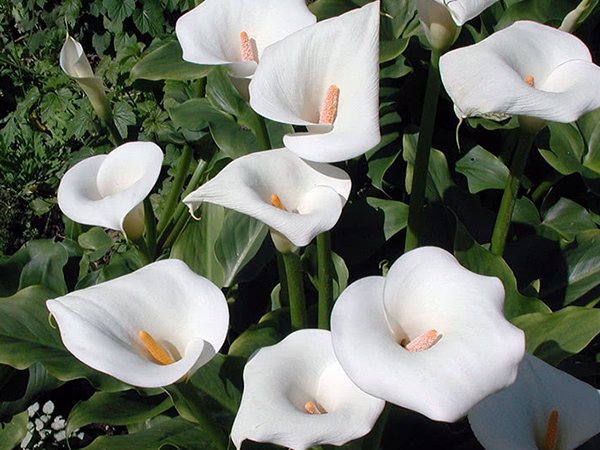

The most common type of calla, grown both for indoor decoration and for floristic bouquets on an industrial scale. Classic flowers white, sometimes with greenish veins.
The height in the pot does not exceed half a meter, and when planted on a garden plot, it can increase up to one and a half.
Amethyst


The amethyst species is a frequent inhabitant of home windowsills... A flower of bright amethyst color, for which it got its name. Leaves are longer than peduncles and cover them with themselves. The flowers have a pleasant fresh scent.
Vermeer
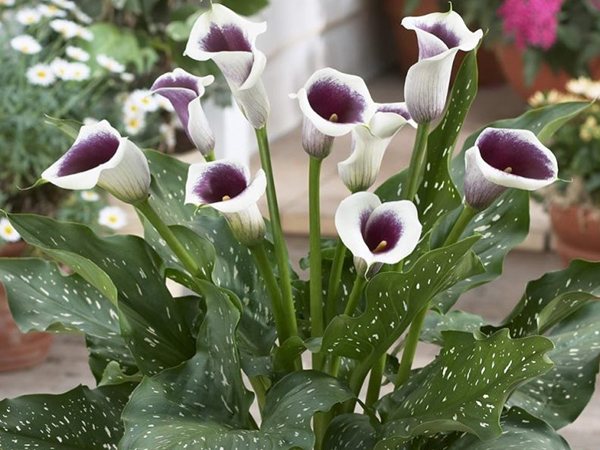

The color of the calla lily blanket from the outer edge remains white, and inside near the inflorescence - burgundy-purple. The ear against this background stands out with a bright lemon color. Even the leaves of this species are distinguished by an unusual color with small white specks.
Types and varieties of calla lilies for growing in the garden
There are the following types of these plants that grow well in horticultural culture:
- Calla Ethiopian;
- Calla Elliott;
- Calla Rehmanni.
Each of these species comes in many varieties. There are also hybrid intervarietal forms.
Calla Ethiopian - a tall plant, reaching a height of 1-1.5 m. Its underground part looks like a rhizome. The flowers are large, their bedspreads are white.
The most popular garden varieties of Ethiopian calla lilies:
- "Childsiana" - a variety with snow-white flowers and a bright orange, almost red center;
- The Green Goddess is a two-color white-green variety.
Calla Elliott - a tuberous plant, reaching a height of 50-70 cm.
Its leaves are colored dark green, and the bedspreads of the flowers are bright yellow or golden hues.
Elliot calla lily varieties:
- "Black Magic" has a yellow flower veil with a wavy edge;
- "Captain Chelse" - a variety that has a purple flower veil with a yellow border;
- "Mango" is a hybrid form with intense yellow-red flowers.
Calla Rehmanni - a small tuberous plant, the flowers of which are painted in a pale pink color.
There are many varieties of this species, differing in a variety of pink, lilac and even almost black flowers.
- "Bolero" - a variety with a dark-colored crimson flower veil;
- "Captain Rosette" - a variety with delicate pink flowers;
- "Black Beauty" - the variety has flowers with a maroon, almost black, veil and a light stripe along the edge;
- "Magestic Red" - is distinguished by solid bright red flowers.
Calla in a pot: home care
Many florists have a question: why calla does not bloom at home. The point is that caring for a plant at home requires compliance with special conditions. This culture is most sensitive to indicators of illumination and humidity, because in nature it grows in open areas around water bodies.
Lighting
The most important parameter when choosing the location of the calla pot. The plant loves bright and diffused light. The pot must be hidden from the direct sun to prevent burns.
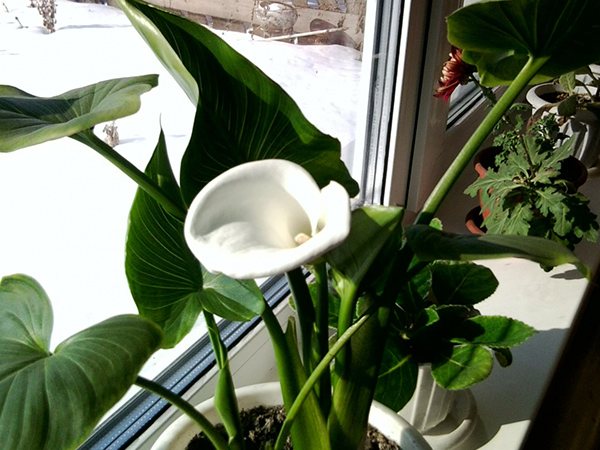

The duration of lighting is required for at least a third of the day, which requires an additional light source in the winter in the evening.
And for the onset of flowering, half a day is needed at all. with diffused lighting, which is taken into account in the spring before the color set, while the sun still does not sufficiently illuminate the windowsills.
Temperature
Calla lilies are grown at temperatures ranging from 15 to 24 degrees.
In the summer season, the plant will be good feel yourself on the street or on the balcony. At night when cool temperatures, it is better to bring the pot into the house.
Attention! In winter, you should not allow sudden changes and keep the plant at 15-18 degrees.
Calla lilies are afraid of drafts, as a result of which they may not bloom for the next season.
Watering and humidifying the air
A large amount of moisture will have a beneficial effect on the growth and flowering of calla lilies. But that doesn't mean what is needed flood the flower. Regular watering is enough, which does not allow the entire soil to dry out. Calla lilies with colored flowers can tolerate short-term drought without worsening, but only in rare cases.
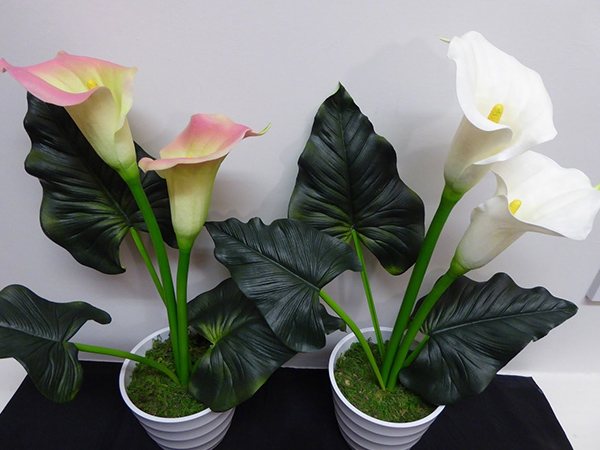

During flowering, zantedeschia needs increased moisture, and after flowering, it must be reduced to the previous regime.
There is no need to deliberately overestimate the humidity, but useful during the heating season or hot summer days spraying with water at room temperature.
Tip: during the flowering period, it is better to replace spraying with regular wiping of the leaves with a damp sponge, so that the flowers do not fall off prematurely from the moisture that has got into the core.
Top dressing and fertilization
It is possible to provide plants with all the necessary minerals and trace elements in a timely manner with the help of fertilizers.
Complex fertilizing is applied three times a month to moist soil.
Important! EIf the pot is constantly in partial shade or in a cold room, then the need for enhanced nutrition increases and fertilization is required once a week.
The nitrogen content in the soil is especially important for lush growth and flowering. Lack of it is manifested by lethargy. leaves and growth retardation, lack of flowering... But its excess is harmful, as it leads to yellowing and drying of the leaves and the absence of flowers.
Nitrogen and phosphorus are contained in superphosphate and potassium nitrate, which are added to the soil before flowering begins.


During the flowering period, universal formulations for flower crops are suitable.
Caring for calla lilies during the rest period
The rest period for some varieties differs in length and usually occurs after the end of flowering. The plant can completely lose its leaves, which more typical for horticultural crops. On the windowsill calla slows down its growth and therefore needs to change the conditions of detention:
- the air temperature drops to 15-18 degrees;
- watering is reduced to 2-3 times a month;
- dressings are excluded during the winter months, from spring they are introduced gradually 2 times a month (organic compounds are preferred - infusion of nettle or manure).
This video shows how you can store Calla tubers in winter.
The Ethiopian rhizome calla variety has a dormant period in the summer, so it needs to provide a cool place with preserved lighting.
Digging and storing calla lilies in winter
Ifeion flowers - planting and care in the open field
Calla lilies are not provided for wintering in the garden, this plant is not frost-resistant, withstands up to -2ᵒС. Every fall, the bulbs are dug up.
Important! To succeed in growing a flower, it is necessary to create conditions for it for a clearly expressed dormant period in winter.
When the callas have faded and wilted, before the cold weather, carefully dig out the tubers so as not to damage the stems. The dug tubers with stems are placed in cardboard or wooden boxes and placed for 2 weeks in a dry room to dry. Then carefully separate the dried stems and roots from the bulb.
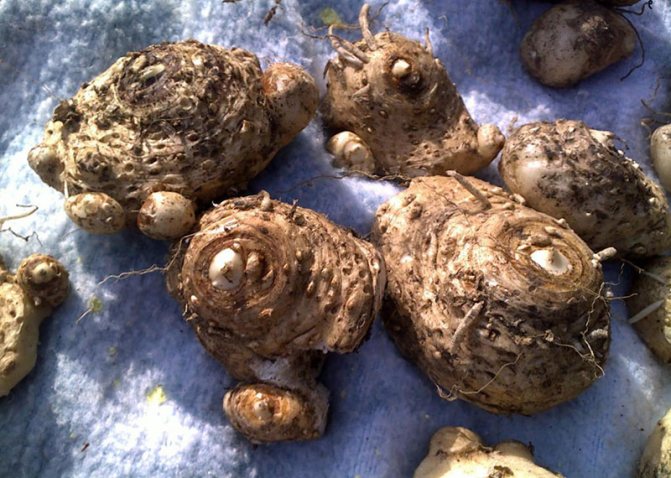

Dug out corms after drying
The latter are well washed and treated in a solution of potassium permanganate, then washed again under running water. When the water drains, the bulbs are removed for a week in a dark, ventilated room to dry.
Note! “Babies” are not removed from the dug out bulbs, it is necessary to wait for the formation of a bridge between the mother bulb and the “baby” in order to break it off without injury for the parent bulb, and later use them for reproduction.It takes a whole year. If you break off immediately, you can damage the bulb, which is fraught with infection and death.
The prepared tubers are ready for winter storage. Before that, once again inspect all the material obtained to identify damage and rot. The detected defects must be removed with a sharp knife. Dry for several hours, then treat all sections with brilliant green or activated carbon.
The planting material for breeding is wrapped in paper, each tuber separately, placed in boxes with holes and stored in a ventilated room with a temperature of 10-12 ° C. Check regularly for rot and dryness.
How to transplant calla lilies
In the process of transplanting domestic calla lilies, important nuances should be taken into account, on which the further growth of the flower depends:
- When planting in a new pot, you do not need to add a lot of land, because because of this, the roots can start to rot.
- Between transplants, the topsoil should be replaced with a new one at least once.
- After changing the substrate, the roots experience severe stress, which is manifested by a long lack of growth. In this case, you should not take any measures, you just need to provide comfortable conditions for the plant.
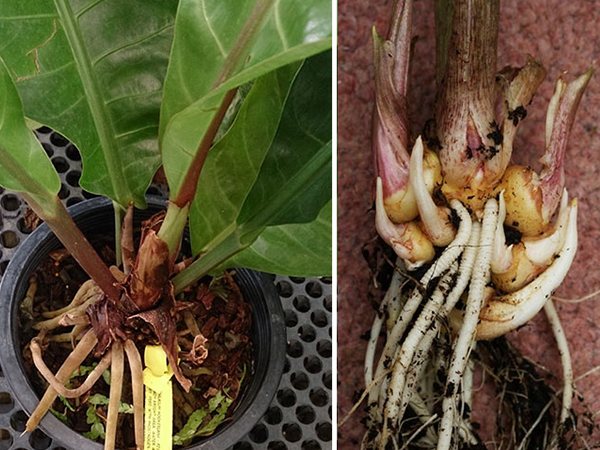

- Damage tuberous skin can ruin the flower, it must be handled very carefully when disembarking.
- In one pot, belongings of the same species can coexist, and calla mix from different colors of bracts is better to plant in different pots. Different species are capable of inhibiting each other's growth.
- The transplant is carried out annually.
Calla is demanding on the capacity of the pot. The ramified root network does not tolerate tightness, in which the appearance of flowers can not be expected. Even high-quality fertilizers will not help. Therefore, one plant should have 20 x 20 cm of soil.
This video shows you how to transplant Calla.
Calla lilies prefer porous soil, which allows air to pass through to the roots and does not retain moisture. Before how to transplant a flower, you need to prepare suitable substrate: mix sand and humus in equal proportions and add 2 parts of leafy soil.
To transplant a plant, a drainage layer is poured onto the bottom of a new pot, and a layer of substrate is placed on top of it. The roots are carefully straightened and covered with soil to the beginning of the leaves.
Possible growing problems
Some problems arise due to violation of the rules of cultivation and care. If the storage conditions are violated, the planting material will be unsuitable for flower cultivation. Callas that are planted too late may not bloom. If the plants were planted too close to each other, they will be frail and small, and the flowers are inconspicuous. Unsuitable, poor soil will also affect growth and flowering. Insufficient watering in hot dry weather can cause insects to appear. Excessive watering will rot the roots and tubers of the plant. Compliance with simple rules of agricultural technology will allow you to successfully grow abundantly and long-term flowering plants.
Callas flowers are not difficult to grow in the garden, the resistance of the plant itself to diseases and pests makes it easy to achieve success. A flower grower, even with little experience, can grow a lush bush with delicate inflorescences.
Growing from bulbs
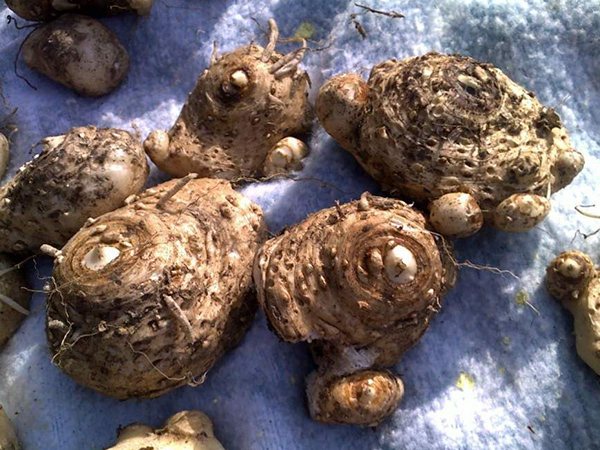

If the desired cultivar is not commercially available among adult potted plants, it is easier to find it in the form of a bulb. But it will be more troublesome, because how to plant a calla a bulb in a pot and growing it is a more difficult task. The best time for planting is late winter - early spring.
The bulb should look healthy outwardly: the skin is yellow, and at the top there are developed buds.
Before planting the purchased tubers, they are kept in a solution of light pink manganese for an hour. This prevents the development of pathogens that may be in the invisible remnants of the old soil after planting.
Important! If, after drying, damage is found on the skin, then these places are treated with brilliant green and dried.
And then the bulb is planted in a prepared pot to a depth of about a decimeter, the soil must be covered with a film or jar on top. Moisturize until it appears leaves need to be very careful so that the roots do not began to rot.
This video tells about the features of growing Calla.
Stages of preparation for planting calla lilies
Hyacinths: planting and care in the open field
April-May is the time of "awakening" of corm calla lilies. At this time, preparations for landing begin:
- Open the boxes they hibernate in and take out the tubers.
- Peel off the paper wrappers.
- Examine for fungal infections.
- Treat with fungicide or potassium permanganate solution.
- Separate the "kids" by breaking them off from the jumper and treating the place where they are broken with green paint.
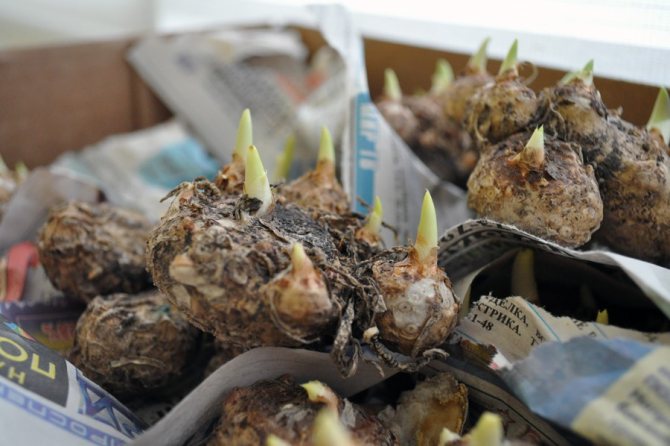

The appearance of sprouts in corms "awakened" after wintering
Possible problems and difficulties
Any plant is susceptible to misfortunes in the form of small pests or diseases, and calla is no exception.
It is important to see the problem at an early stage and take the necessary action right away.
Calla lilies diseases and care during this period
The appearance of insects can be recognized by the following signs:
- The leaves begin to curl and become covered with light spots, the peduncles are painted with light patterns. The disease is called yellow spot. and the causative agents are insects - thrips. To fight with them, the plant is treated with a diluted insecticide for flowers (Fitoverm, Aktara, Fufanon).
- A spider mite is manifested by dry leaves and the formation of small cobwebs on them. It develops in dry indoor air, which requires adjustment after treatment with drugs.
- Deformation, curling and further leaf fall can become signs of aphids on calla lilies. Insects feed on sap from leaves and leave sticky spots. In the fight against pests, it is effective to wash them off with a solution of soap in the early stages or treat them with drugs:
- Aktara;
- Tobacco dust;
- Spark.
Processing is carried out several times with a break of 1 week.
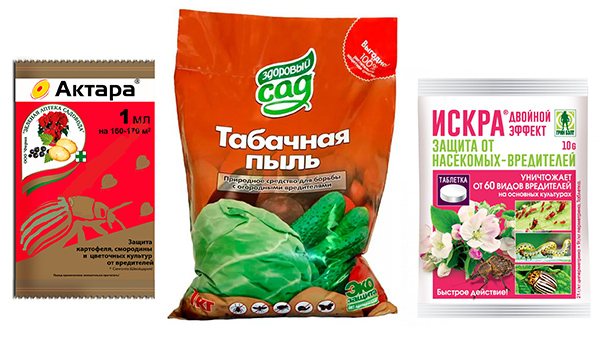

Also, if the rules of care are not followed, the plant begins to wither or stops growing.
Elongated leaves and stems with pale coloration are observed with insufficient lighting time or lack of its intensity.
With a lack of nutrition, the leaves begin to break off, which is usually combined with a lack of growth and flowering.
Anthracnose
Anthracosis may be one of the reasons why the leaves of room calla lilies turn yellow. Brown spots resembling rust appear on the leaf plates. Later, the leaves dry out completely and fall off.
Anthracosis requires the removal of damaged areas and treatment with a fungicidal agent.
Gray rot
The appearance of a gray bloom on the leaves indicates the presence of a fungal disease. Treatment with a fungicidal preparation (Vitaros, Fundazol) can save the plant.
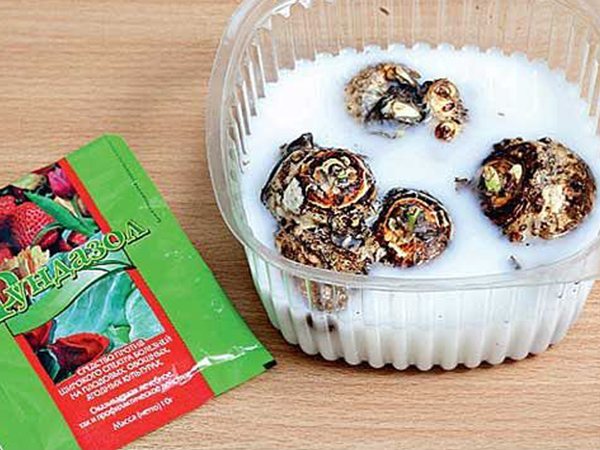

To prevent subsequent infection, frequent airing the room and reducing watering and spraying.
Bacterial rot
Bacterial rot develops on roots in a too moist substrate. The disease is manifested by leaf decay and their death. Tubers or rhizomes are covered with dark spots. The plant is very difficult to salvage, even at an early stage. Must be cut completely all affected areas, process and plant in a new soil, reducing the frequency of watering.
Root rot
Sudden drying of leaves or flowers may be the result of over-watering and root development. rot. The soil should be cultivated to combat it. Ridomil or Previkur, and replace the upper part with a new one. Prevention is moderate watering and periodic replacement of the upper layer of the substrate.
Lack of flowering


If calla lilies do not please their owner with elegant flowering, then the most probable reasons lie in improper care of the plant:
- Lack of space in the pot, which does not always affect the growth rate of foliage, but may be the reason why calla does not bloom at home.
- Insufficient lighting and frequent moving the pot from place to place. The flower is forced to constantly be under stress and adapt to new conditions that leave no energy for education buds.
- Lack or lack of dressing, especially before the start of the active period. The alkaline reaction of the soil may also be the reason, which does not allow food to be absorbed by the root system.
- A short duration of the resting phase in a cool place, during which flower buds do not have time to develop.
- Overgrown tubers requiring transplanting.
- A large amount of soil in a pot, contributing to the development of putrefactive processes.
Calla lily diseases
Garden calla lilies are most commonly affected by common diseases such as wet rot and yellow spot.
Wet rot is a bacterial infection. Her signs:
- Rot of peduncles and leaves;
- Sluggish rotten roots;
- The presence of rotten brown spots on the tubers.
The plant can be saved only at the beginning of the disease during wintering or before planting in the ground. All diseased parts of the tuber are removed, the sections are covered with a solution of brilliant green. If the disease manifests itself in the summer, the diseased plant must be removed from the planting and destroyed.
Yellow spot is a viral disease... Its main manifestations:
- Curly leaves;
- Deformation of flowers;
- Light spots on the leaves.
There are no cures for this disease. For the purpose of prevention, thrips are destroyed - pests that are its carriers. To combat thrips, insecticidal preparations are used.
Of the pests, garden calla lilies are most often attacked by aphids and spider mites. Timely processing of the planting with Actellik or Fitoverm preparations will help to completely get rid of harmful insects.
Indoor temperature
Growing calla lilies in a pot is a simple process. Of course, if you follow certain rules. Do not forget that calla lilies usually grow in southern latitudes, where temperatures are constantly high. These plants are very difficult to tolerate when this figure drops to 8 ° C. Therefore, keeping calla lilies on the balcony is only worthwhile in warm weather. In winter, the plant should be transferred to a room where heating devices are installed. The most favorable temperature for the growth of calla lilies is from 20 to 25 ° C.


Gallery: Calla flower varieties
Storage rules for dug tubers


Dug calla tubers
Plant care involves various activities throughout the season. In September, the bulbs should be prepared for wintering. You need to dig out the tubers even before the first cold weather. Dig it out carefully, so as not to harm the root. Next, the root is washed from water and rinsed under running water. All manipulations with the roots should be carried out especially carefully, since they are very fragile and easily damaged.


Preparing tubers for storage
After digging, the tubers are placed indoors for up to two weeks. Place the tubers in paper bags or cardboard boxes with many holes for ventilation. It is important to maintain a distance between the tubers and take care of free access of air: in this case, they will be preserved correctly, and in the case of a diseased tuber, isolation will help to avoid the spread of the disease. The soil for the box can consist of moss, sawdust, vermiculite, and shavings. In case the tubers are shriveled or dry, they can be poured with water from a spray bottle.
The temperature conditions in the room with roots should fluctuate between + 5-15 ° C. The room should be well ventilated and not too humid.It is advisable to equip the room with a hood or ventilation to create optimal conditions for seedlings. In two weeks, the leaves will have time to transfer the necessary substances to the tubers for successful development.
Calla flowers - features
Growing calla lilies, like any other plant, involves following the rules of agricultural technology, the main feature of these flowers is that they are grown both as garden calla lilies - in yards, and in apartments, in pots, like indoor calla lilies. But the general rules for growing and caring for calla lilies, wherever they grow, are still there:
- calla lilies require shallow planting, that is, the rhizomes are barely covered with earth to avoid rotting;
- what amateurs call the calla flower is actually the cover leaf or blanket that wraps around the ear of the flower head. In fact, calla flowers are small and inconspicuous, although very fragrant;
- after planting, calla does not emerge until it forms its root system, so do not be nervous if there are no shoots for a month;
- be careful when digging up tubers: they are easily damaged;
- calla is a living barometer: before the rain, drops of water appear on its veil and tips of leaves, like tears;
- a pot for calla lilies, especially Ethiopian, is preferable to be porous so that excess moisture can evaporate. In addition, the Ethiopian calla loves solitude and does not tolerate neighbors in their own pot;
- each calla flower blooms for about a month;
- From time to time, the top layer of the calla lily pot should be carefully removed, taking care not to damage the roots, and replaced with fresh nutrient substrate.


Reproduction


By dividing the rhizome
One of the available methods of reproduction of callas is the division of the rhizome. During the period of active growth, an abundant growth occurs, which surrounds the mother rhizome. Having dug it out for the winter, the root processes and the main stem are separated and planted in pots. In the spring they can be planted in a flower bed.


Reproduction of flowers from bulbs
When calla lilies are grown, babies quickly overgrow its bulb. If it is not replanted annually, the entire surface of the soil will be covered with young seedlings, which will make it difficult to care for them. Transplanting plants from one such flowerpot will allow you to get enough planting material.
When removing the tuber from the soil, it is necessary to carefully manually separate each child with a kidney. It can be used for planting, both for open ground and for a pot. A slight delay in the extraction of the bulbs leads to the accretion of the babies and the mother's tuber. Then the rhizome is simply broken into several parts.
For sprinkling the resulting wounds, crushed coal is used.
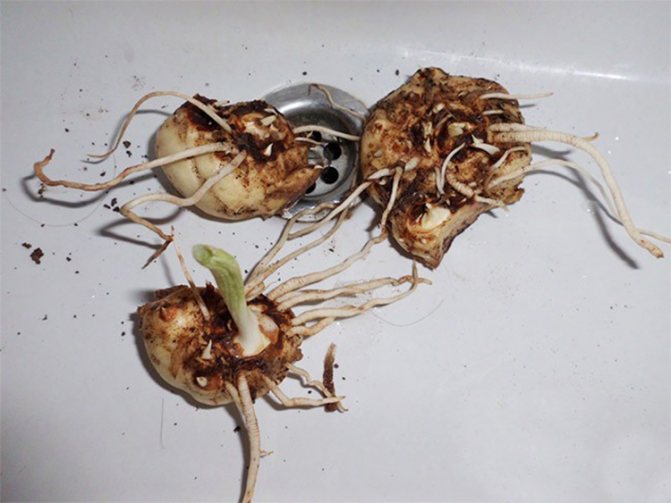

Propagation using seeds
For calla lilies, seed propagation is possible. The presence of pollinating insects in the room is not always observed. Often, to obtain seed, pollen is transferred from one flower to another by hand with a brush.
There is no need to store the seeds. Fresh have better germination. Once collected, immediately wrap in a damp cloth and leave in a warm room. After two days, they will begin to hatch. Swollen seeds are sown in moist soil for growing seedlings.
To prevent rotting before germination, do not water.
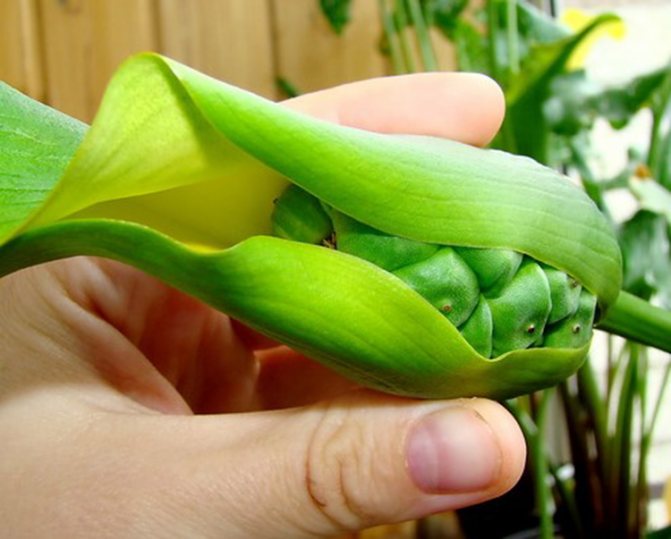

To moisten the soil, the pan is filled with water, which will flow through the drainage holes. The dried topsoil is sprayed with a spray gun.
When the first sprouts appear, the pot is placed in a bright place and the temperature is maintained at + 22 ° C. Seedlings dive into separate flowerpots after two months, and plants are planted in a permanent place after a year.
Some growers do not practice picking, they sow 2 swollen grains in glasses. Having chosen a strong one among the emerging seedlings, it is left, and the other is thrown away or transplanted into another pot.
Young plants are demanding watering as the soil dries up.
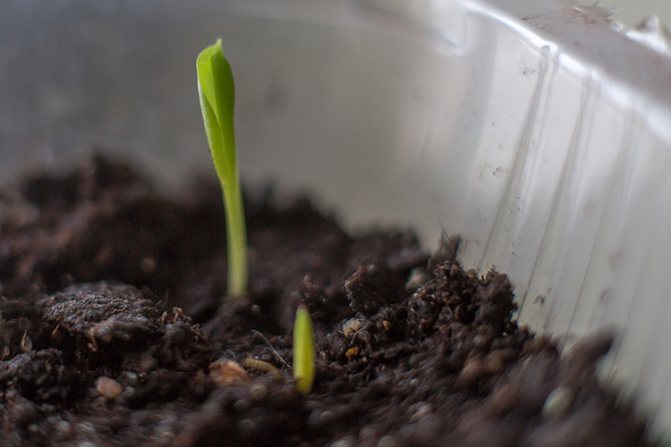

Pot and soil selection
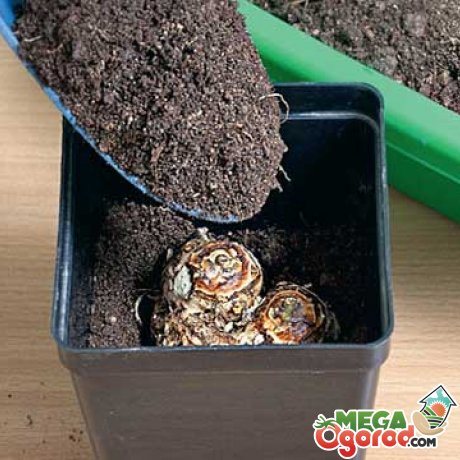

The pot in growing an indoor flower plays a rather important role. If you are growing Ethiopian calla lilies, then it is necessary to select a container that is characterized by large sizes. When using a small pot in this case, calla lilies will not bloom. If you apply fertilizer to a small container, then you will achieve the growth of only the green part of the plant.
For planting one flower, a container is selected whose diameter is more than 20 centimeters.
When choosing a soil for growing a houseplant, it is necessary to give preference to porous structures. This allows you to remove excess moisture from the pot as efficiently as possible and provide the plant with normal respiration. In order for the plant to grow constantly, it is necessary to carry out the correct selection of the soil mixture. For this purpose, most often a special mixture is used, which includes garden soil, rotted manure, sand. In this case, it is necessary to provide an indicator of soil acidity.
With the correct selection of capacity and soil for calla lilies, its full flowering is ensured. Also, this process greatly facilitates the work of the grower in the process of growing calla lilies.
After flowering
It should be noted that the care of rhizome calla lilies and tuberous calla lilies has some differences. For example, in the Ethiopian calla lily, which belongs to the first type, the dormant period begins during the hottest time of the year. At this time, her growth slows down, after which it stops altogether, and the plants begin to turn yellow. The culture is taken out on the balcony or in the garden, displayed in a well-lit place. But at the same time, it is worth paying attention to the fact that the plants should not get the raindrops.
In early July, calla lilies should be removed from the container, all offspring and old leaves should be removed, transplanted into a pot, where a new nutrient mixture is poured. After that, the container with the plant is placed in a bright place, watering and feeding begins. This prepares the crop for the next bloom. This is how the cycle looks like in rhizome varieties of calla lilies.
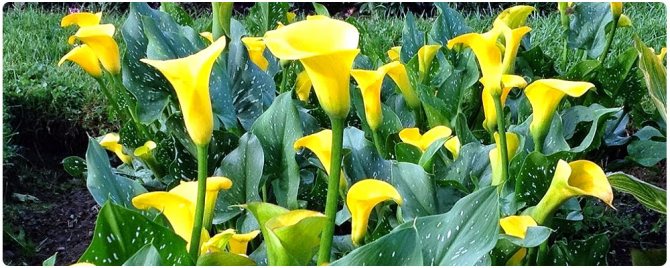

Garden varieties remain on the site until the onset of autumn, and in September, the rhizome must be dug up and stored together with an earthen lump in some cool and dry room. Watering should be infrequent and moderate.
In tuberous varieties, after flowering, the bedspreads turn green and droop over time, the leaf plates turn yellow and dry. Garden varieties should be carefully dug in the third decade of the first autumn month, while trying not to harm the tubers. They are freed from the soil, washed and kept for two weeks at an air temperature of 5 to 10 degrees. Under these conditions, all useful nutrients must pass from the leaf plates to the tubers. Then the dead leaves can be easily removed.
Common growing questions
- Is a shaded, not completely dark place suitable for wintering tubers? Lighting does not play a role for storing tubers. Many growers store them in refrigerators, where the light is known to turn on only when the door is opened.
- Can a pot of calla lilies be taken outside in summer? Experts recommend taking rhizome calla lilies outside in the summer. Tuberous species also tolerate garden conditions well.
- After buying calla lilies in winter, how and when to send them to rest in this case? In such cases, you should observe the flower. As soon as it begins to turn yellow and dry out, this will be a signal of the need for rest.
- Do I need to disinfect the pot if the tubers have rotted, and what is the best way to do it? After rotting, be sure to disinfect the flower pot. If it is made of durable materials, it can be boiled. If it is plastic, it is treated with alcohol.
All calla lilies are divided according to the principle of the organization of the root system into tuberous and rhizome.Despite the external similarity, these are different plants that require special care. If you do not follow the rules, then the flower will not bloom and may even die.
Is it possible to keep calla lilies at home
If you organize the temperature and humidity of the air close to natural, the culture develops normally and blooms in a pot on the windowsill. The question is different, flower growers are interested in energy compatibility with calla lilies.
The South African flower is shrouded in mystery and mysticism. According to some beliefs, it is believed that the plant is a divine amulet, a talisman for good luck, since it bloomed next to the cross on which Jesus was crucified, it is present in the images of angels, the Virgin Mary.
Others are sure that calla blooms on the eve of death, it is appropriate for a funeral rite, as it looks like a yellow candle wrapped in a white shroud.
Most flower growers are of the opinion that calla brings prosperity to the family, reconciles quarreling spouses. A pot with calla lilies in the office maintains a friendly atmosphere in the team, helps in negotiations with business partners.
It has been noticed that calla, flowering at home, relieves the condition of patients with heart failure.


Which varieties are suitable for home cultivation
The height, color of flowers, type of root system depends on the species of calla lilies. The ancestor of domesticated crops, the Ethiopian calla is distinguished by its 1.5-meter height, snow-white color, and the presence of rhizomes.
Elliot's varieties are yellow and golden, up to half a meter high. Calla lilies of the Remann type are pink with low peduncles. In the latter two species, the underground part is represented by tubers.
Common varieties adapted for home cultivation:
- Schwarzwalder. Flowers almost black with a burgundy tint look very impressive. The average plant height is 60 cm. Flowering begins in mid-July and ends by September. The culture is decorated with bright green, erect leaves with white spots.
- Vermeer. The color of flowers is white outside, inside - closer to purple. The ear is bright, canary-colored. The decorativeness of the plant is given by white blotches in the rich green of the leaves.
- Mango. The variety is suitable for growing on a windowsill and outdoors. The yellow ear, golden-orange cover of the peduncles looks good when cut. The leaves are green with silvery specks.
- Amethyst. The color of the flowers corresponds to the name. The potted culture gives off a pleasant, delicate aroma. The leaves grow above the peduncles.
- Red Alert. The variety stands out for its large red flowers, large speckled leaves. Red Alert differs from other varieties by long flowering - the entire summer period.
- Hot Shot. Popular tuberous plant. Translated from English - a hot shot. Depending on the time of flowering, conditions of detention, it changes shades from peach to orange-red. Above, the leaves are of a standard color, brown veins are visible from the inside.


The presented varieties are similar in appearance. The average height of the plants is 60 cm, the size of the flowers is 10 cm. The inflorescence consists of a cob and a blanket that forms a funnel. The basal leaves are shaped like an arrowhead, the color is green with silvery-white blotches.
Description and features of the flower
Calla (Zantedeschia) is native to tropical South America and Africa and enjoys a sultry, humid climate, but it easily adapts to areas with drier and cooler air. The closest relative is the marsh calla, which grows in swamps and coastal areas. Having created suitable conditions, the plant can be grown in the garden or decorate flower beds, in addition, the flower is in demand for decorating window sills and wedding bouquets.
The flower got its name from Karl Linnaeus, and it looks quite original: on a thick stalk there is an ear covered with a white (or another, the color depends on the variety) blanket with a sharp tip looking up.Leaves are basal, long, oval, 20-30 cm in height, and 11-15 cm in width, looks like an arrowhead. The color of the leaves depends on the variety and type, but most often they are dark green or green with creamy splashes. The unusual flower exudes a pleasant and delicate vanilla aroma.
The root system is of two types: tubers and rhizomes. The height of the plant can vary from 30 to 150 cm. The flower propagates by seeds and tubers or by dividing the root.
What parasites are calla lilies
The beautiful flowers of calla lilies and their huge leaves are often attacked by insect pests. It is possible to prevent the appearance of insects if, before planting plants, the ground is thoroughly dug up, weeds are removed and, for prevention, sprayed with biological insecticides.
Calla leaves usually infect ticks, aphids. Wireworms and thrips feed on tubers. The caterpillars of the cabbage scoop eat huge holes in the leaves. If insects are found, calla lilies are sprayed with chemical insecticides (Commander, Iskra, Aktellik).
The choice of planting material (tubers)
As noted above, plants can be of different types. Hence, calla can be planted with tubers or rhizomes. For example, the reproduction of Remani and Elliot calla lilies is carried out by tubers, but the white Ethiopian variety has a branched rhizome, therefore it is propagated by the method of dividing the mother bush.
Growing calla lilies of all types is also possible from seeds., however, the method is very laborious and unpromising. In addition, with this method, varietal characteristics cannot be preserved, so it is used very rarely.
Planting rhizomes will be discussed below. Now we focus on on the selection of calla tubers:
Tips for choosing quality planting material:
- You can see the tubers of this flower culture already in February. It is recommended to buy planting material in reliable and proven garden centers, specialized stores... Read reviews of real buyers, ask your friends what they think about certain points of sale.
- Tubers must be dense (should resemble young potatoes in texture). Only such material can please you with flowering in the first year after planting.
- But if you come across sluggish, shriveled tubers in the store, then it is better to discard such a specimen once and for all. Nothing good will grow out of him, it's just a waste of money.
- And of course, on the planting material there should be no traces of mold, rotting, damage.
- The optimal tuber diameter should be at least 4 centimeters.
Immediately after purchase and before planting, you need to put the tubers on some clean pallet and put in a dry place where the temperature is maintained at 5-7 degrees Celsius. During storage, you need to regularly turn them over and ventilate the room. It is under these storage conditions that germination can be prevented.
Requirements for growing conditions
Growing calla lilies on the windowsill is possible even for novice amateur flower growers who follow the care recommendations. It is required to create conditions close to natural.
Illumination
Kalle needs continuous lighting throughout the year, including a dormant period.
Lack of light leads to yellowing of foliage, lack of flowering or faded color.
Direct sunlight causes leaf burns, so the plant pots located on the windowsill are fenced off with translucent tulle.
Temperature regime
Ethiopian white calla lilies thrive in temperatures between 18-20 ºC. Plants overwinter in heated rooms with temperatures not lower than 14-18 ºC.
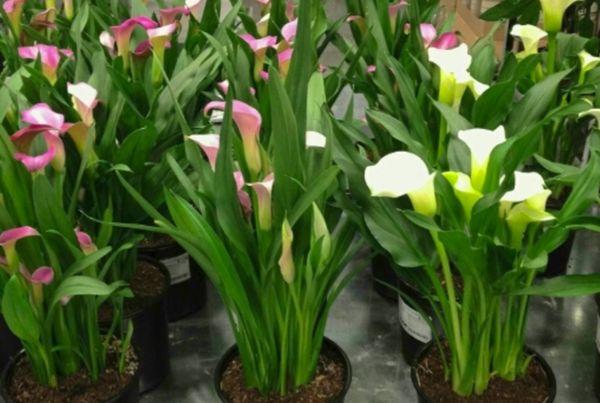

For colored tuberous calla lilies, the optimal temperature range is in the range of 22-25 ºC. The dormant period of the bulbs is safely tolerated at + 3-7 ºC. Sharp temperature jumps lead to the cessation of flowering. On the loggias, open terraces calla lilies are carried out only in summer.
Humidity
Moisture is an important factor in growing a plant. In the subtropical swamps of South Africa, where calla lilies come from, the humidity is high - 70-80%. If the indicators in the apartment do not correspond to the norm, the culture is sprayed twice a day - in the morning and in the evening, the leaves are regularly wiped with a damp cloth.
Required soil composition and pot size
Despite the lightness of the products, a wide range of different volumes and configurations, the plastic pot is inferior in quality to the earthen one. Pottery is porous, which allows excess moisture to evaporate. They have a universal color suitable for different types of calla lilies.
See also
Types and varieties of a flower rejuvenated, description and features of reproductionRead
For Elliot and Remaney species, pots with a diameter of up to 20 cm are needed. For children, even less - 10 cm. Ethiopian calla lilies with a developed rhizome require a container with a diameter of 30–40 cm, a height of 60. Suitable soil for calla lilies consists of equal parts of peat, garden soil, sand and two parts of organic matter - humus or rotted manure. The soil should be slightly acidic, the optimal pH is six.
Lighting
So, calla lilies in a pot, home care for which does not require much effort, are very demanding on light. In addition, it is a thermophilic plant. These two facts should be considered when choosing a place. This is one of the basic rules of success. Calla lilies grow well in places where there is diffused sunlight or partial shade. There is one more peculiarity. Callamas in the evening need a small portion of the direct rays of the sun. For the formation of peduncles, these plants need a day of light lasting more than 12 hours. This is one of the important conditions. After flowering, daylight hours should be at least 8 hours and no more than 10.
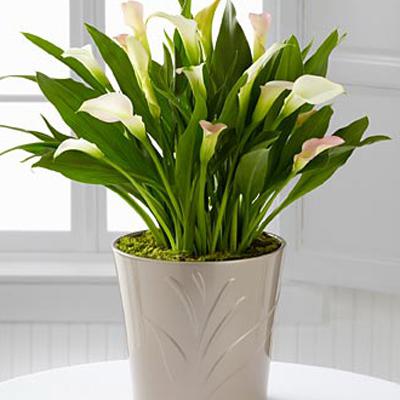

Flower diseases
Callas can get sick. Most often, plants suffer from a fungal infection. The disease can be provoked by rainy, cool weather, lack of nutrients in the soil. As a preventive measure, it is recommended to spray the culture with a biological fungicide before flowering. When signs of a fungal infection appear, the plant and soil are irrigated with a chemical fungicide. Diseased leaves are removed.
Anthracnose
Fungal disease. Brown spots appear on the leaves of calla lilies. Subsequently, the plant turns yellow and withers.
Gray rot
Fungal infection. Grayish spots appear on the leaves and stems. Preventive spraying with the fungicide Fitosporin saves from the fungus.
Bacterial rot
Wet bacterial rot appears on corms, stems, and at the base of leaves. As a preventive measure, the bulbs are treated with a weak solution of potassium permanganate before planting. Diseased plants are removed from the garden.


Root rot
Burgundy spots appear on the corm. The disease often develops in moist soil. Despite frequent watering, calla begins to fade.
Plant classification
Callas differ in height (from 25 to 155 centimeters), the structure of the root system (with rhizomes or tubers) and the color of the bracts.
By the type of garden flowers
Calla lilies differ in appearance and color of the veil surrounding the yellow cob. It should be remembered that in all varieties, without exception, the color of the bedspread turns green after pollination. The original color disappears.
Ethiopian
Grown as indoor and garden culture. Originally from South Africa. It is a rhizome plant with a snow-white bracts and a yellow ear. Leaves are wide, heart-shaped, dense. The bedspread is funnel-shaped, expands at the top, and has a short-tubular shape at the base. The height of the plant sometimes reaches 155 centimeters. Used to create bouquets and landscape decoration. Popular varieties: Golden Goddess, Childsiana.


Elliott
Plant with yellow inflorescences and large, smooth, heart-shaped leaves. Propagated by tubers. Calla lilies are 50 centimeters high. Leaves are wide, greenish with white dots.The bedspread is long, yellowish-green on the outside, yellow on the inside. Popular varieties: Selina, Black-eyed beauty.
Remani
Low culture (up to 50 centimeters in length) with pink flowers. Propagated by tubers. It has green leaves with white dots. Spends the winter in hibernation. Drops all the leaves in the fall. Famous varieties: Bolero, Little Susie.
Rhizome (marsh)
A short plant (25 centimeters) growing in a swampy area. It has a thick, greenish, creeping rhizome located on the surface of the earth. Leaves are heart-shaped, pointed at the top. The cylindrical ear is surrounded by a snow-white, flat, ovoid blanket on the inside. Used in landscaping to decorate artificial ponds.
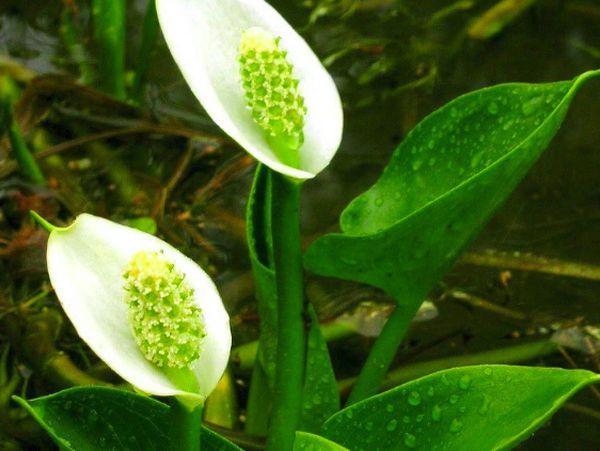

By color variety
According to the color of the bracts, calla lilies are divided into white and colored. Whites are descended from the Ethiopian variety. They are taller (up to 150 centimeters long), have a long rhizome, like moist soil, and prefer to grow in partial shade.
The pink calla lilies of Remani and the golden yellow calla lilies of Elliott are considered the ancestors of flowering plants. The height of such flowers rarely exceeds 50 centimeters, they grow from a tuber. Plants are less demanding on soil moisture, but they need good lighting.
Black
A rare variety of calla lilies with a maroon or dark purple bracts. The plant grows up to 0.4-1 meters in height, has long, pointed, greenish mottled leaves. Propagated by tubers and seeds. Notable varieties: Black Crusader, Black Star, Captain Palermo.
Red
Elegant flowers with a rich red or slightly scarlet veil. Height - 0.4-1 meter. Leaves are heart-shaped, greenish, with white specks. Refers to tuberous plants. Popular varieties: Majestic Red, Red Sox, Sanglow.
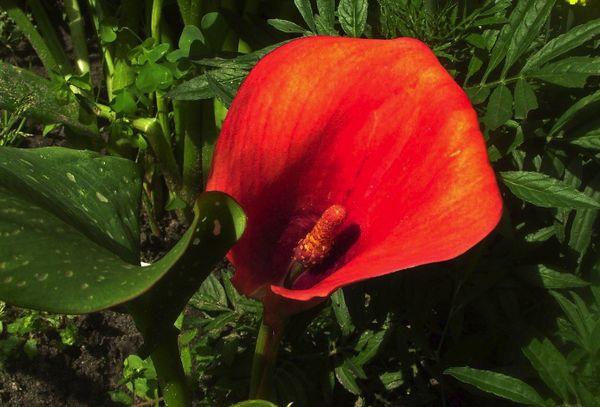

Yellow
Beautiful flowers with a delicate lemon or rich tangerine veil. Plant height - 0.5-1 meter. Leaves are heart-shaped, shiny, greenish, pointed. Propagated by seeds and tubers. Known Hybrids: Captain Amigo, Captain Cupid, Yellow Giant.
Purple
Graceful purple or lilac flowers wrapped in a narrow tube, and extended upward with a blanket. Leaves - pointed, arrow-shaped, green, speckled. Tuber culture. Known hybrids: Amethyst, Picasso, Ash Hayes.
Pink
Pink flowers hybridized from wild African species. The stem height is 30-90 centimeters. Leaves are oblong, green, growing from below. Propagated by seeds and tubers. Famous varieties: Zantedeschia white-spotted, Ethiopian, Zantedeschia Elliot, Remania and others.
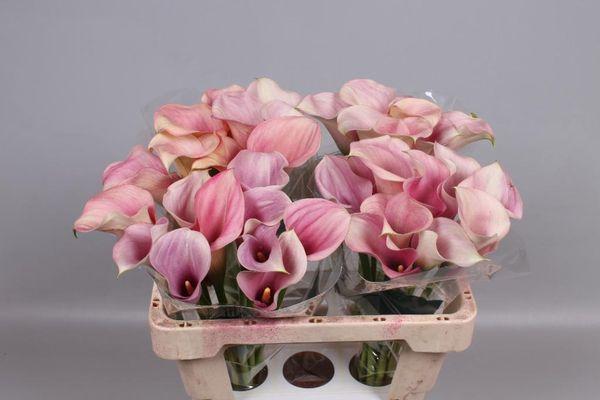

Burgundy
The plant is 0.4-0.9 meters high with a burgundy bedspread. Leaves are green, speckled, heart-shaped. Tuber culture. Popular varieties: Schwarzwalder, Majestic Red.
White
Snow-white flowers symbolizing purity. Plant height - 50-150 centimeters. It has long, greenish, heart-shaped leaves. Known varieties: Ethiopian childziana, Ethiopian Khazmanta, Hercules, Cameo.
Orange
Beautiful flowers with an orange veil. Height - 30-70 centimeters. Leaves - oblong, green, speckled. Tuber culture. Popular varieties: Mango, San Remo.
Blue
Flowers symbolizing tranquility and nobility. The bract veil has a pale blue or deep blue color. Leaves are oblong, heart-shaped, greenish. Known varieties: Ice blue, Teal blue, Merlin blue.
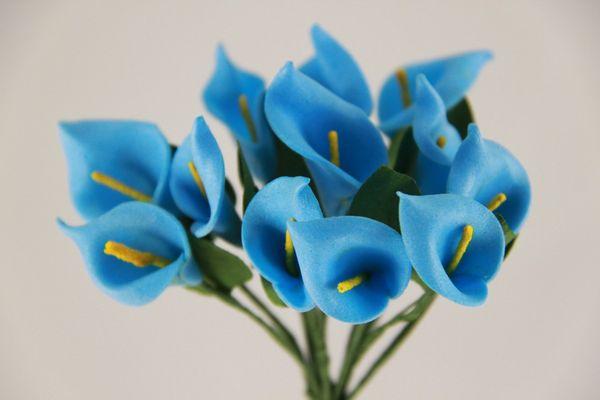

The best varieties for planting
Callas are divided into tuberous (Remani, Elliott) and rhizome (Ethiopian). Based on these varieties, a huge number of varieties have been bred. The varieties derived from the Ethiopian variety have white inflorescences and tall stems. Tuberous calla lilies (Remani, Elliot) gave rise to undersized, multi-colored varieties.
See also
Planting and caring for clover, a description of the 25 best varieties and speciesRead
Cantor
Exquisite dark purple, like wax, flowers.The height of the culture rarely exceeds 60 centimeters. Leaves are greenish with white dashes. Bloom - from July to September.
Mix
The culture is 40-60 centimeters high. Has inflorescences of various shades. Leaves are vertical, spear-shaped. Blooms for one month. It reproduces more often by tubers.
The Snow Queen
This is a garden calla with snow-white, almost transparent, and greenish leaves along the edges. The flowers stand out effectively against the background of white foliage, the bracts of the calla lilies are of a deep pink hue.
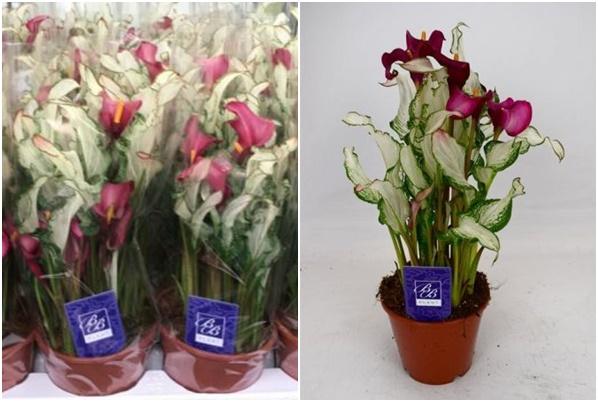

Chameleon
Delicate plant with creamy, slightly pinkish and yellowish flowers. Forms a lush rosette of wide, greenish leaves with a white speck. The height of the culture is no more than 65 centimeters.
Casper
A short plant with a lush rosette of green, arrow-like leaves and bluish peduncles. It reproduces more often by tubers. Blooms from July to August.
Mozart
A plant with a lush rosette of dark green, white speckled, wide leaves and peduncles with bright orange, slightly reddish flowers. The height of the culture is about 75 centimeters.
Remani
This variety has beautiful pink flowers. Leaves are wedge-shaped, greenish, growing from the base of the stem.
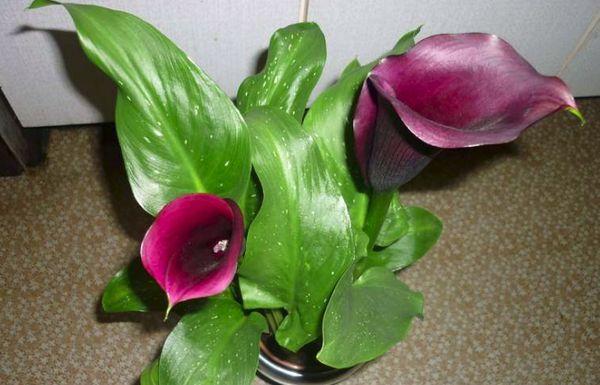

Black star
Differs in an interesting maroon inflorescence. The leaves are narrow, like spears. Calla lilies are 60-70 centimeters high. Blooms all summer.
Captain Promis
A showy plant with deep purple flowers. It grows up to 55-65 centimeters. The leaves are large, dark green, with occasional light blotches. Blooms throughout the summer.
Remann
A lush plant with pink flowers and greenish, oblong leaves. Reaches a height of 40-70 centimeters.
Gold medal
A beautiful, low plant with graceful rich yellow flowers. The leaves are oblong, arrow-shaped. Blooms from July to August.
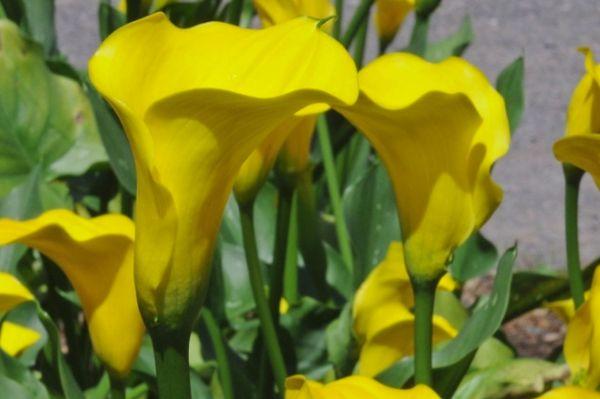

Rudolf
Maroon, funnel-shaped flower with a long stem. The plant forms a lush rosette of large greenish, speckled leaves and several peduncles. Height - 50 centimeters.
Mango
A low plant with a lush rosette of large, dark green leaves with small light specks. Flowers are rich orange. Blooms from July to August.
Garnet Glow
A beautiful flower 60 centimeters high with a lush rosette of green, large, oblong leaves. In early June, inflorescences of a pale pink hue appear. Calla blooms for almost 3 months.
Paco
An exotic-looking plant with delicate purple flowers. The leaves are oblong, dark green, reminiscent of arrowheads. Blooms for 1.5 months, from July to September.
How to propagate a houseplant at home
Callas can be propagated by tubers, scions and seeds. Among flower growers, only the first 2 breeding methods are very popular.
Tuber propagation
Only colored varieties of zantedeschia reproduce with tubers. The procedure consists in separating the daughter tubers from the parent root system. This method of reproduction is very convenient to use, especially since calla lilies give a good increase in children per year.
Daughter tubers are effortlessly separated. The divisions must be treated with crushed activated carbon. The size of the baby should not be less than 0.5 cm in diameter.


Tuber processing
Young tubers less than 1.5 cm need to be grown. They are planted in peat-sandy soil and kept at high temperatures. Tubers with a diameter exceeding 1.5-2 cm are planted as adult flowers.
Seeds
Flowers are rarely propagated by seed. This is a very lengthy process. In addition, zantedeschia do not germinate well. Most often, breeders use this method.
The propagation of calla lilies by seeds involves the following actions:
- The seeds are soaked for 6 hours in a preparation that stimulates growth.
- After soaking, the seeds are spread on a damp cloth and placed on the windowsill for pecking. As it dries, the napkin is moistened again.
- Sprouted seeds are placed in a peat-sandy soil, deepening by 1 cm. There they remain until they get stronger.
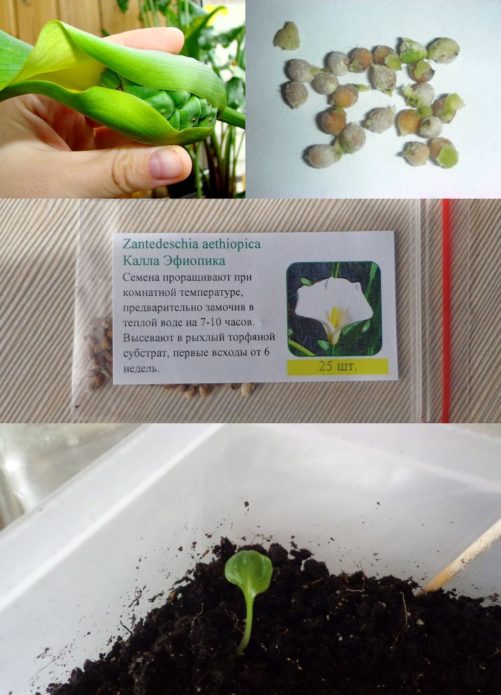

Calla lily propagation by seeds
In order to avoid rotting of the seed, watering is carried out only through the pallet.
By shoots
White zantedeschia reproduce by shoots. This method, like tuberous, is simple and effective. In the process of transplantation, offspring can be seen on the rhizome of the flower. Very often they already have their own sprout.
With the help of a sterile sharpened knife, the offspring is cut off from the rhizome. The cut site is disinfected.
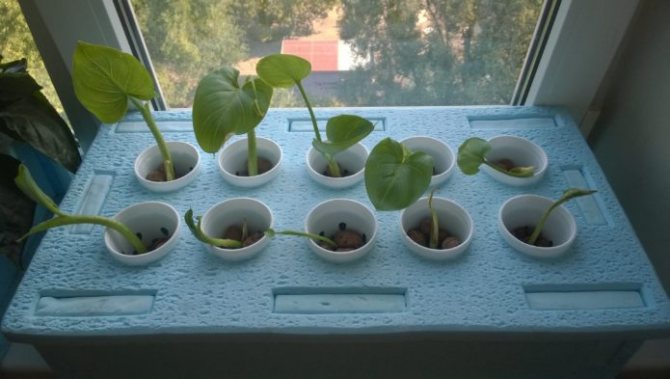

Only those offspring that have their own growing point and roots can be separated from the mother bush.
The offspring are planted as adult plants, since they do not need additional care. Even if the grower needs only 1 offspring, he must certainly free the flower from all the children. Otherwise, the calla may not bloom.
Choosing a landing site
In order for calla lilies to invariably delight with dark green luxurious foliage and abundant flowering, it is extremely important to choose the right site for planting it, consider how to do it correctly:
- This plant develops better and blooms longer, and the covers of the inflorescences have a brighter color when grown in open areasbeing shaded from direct sunlight during the hottest hours.
Advice... It is worth planting calla lilies in the rare shade of a dwarf mountain ash or willow, in a rabatka on the east side of the building or near a pergola. - Calla is one of the most moisture-loving flower garden plants, the ideal place for it is an area near the reservoir, where the leaves will receive additional moisture from the air.
- It should be borne in mind that this the flower needs slightly acidic or neutral soil... In no case should the plant be planted on calcareous soils, if there are construction waste in them, which usually have an alkaline reaction.
- Callas are great materials for landscaping.... If there is enough space, you can create an original flower bed or rabatka by planting one of your favorite varieties. This uniform fit looks extremely decorative.
Advice... Plant a dense group of calla lilies of at least 10 plants on your lawn or outside. Such a flower bed-bouquet looks charming, including 2 or more harmoniously combined colors, for example, white, pink and dark purple.
Popular types
Thanks to the hard work of botanists in breeding this plant, today we are able to cultivate a large number of different types of domestic calla lilies.
Calla elliottiana
- a profusely blooming flower variety characterized by a special love for illuminated places and regular watering. The flower is painted in very contrasting colors: the outer part is yellow-green, and the inner part is bright yellow.
Ethiopian calla (Calla aethiopica)
- rightfully this variety ranks first in popularity. Calla flowers are white with a yellow core, the only leaf of the flower is curled up and has an extension towards the top. The dense leaves of this species can be up to 45 centimeters in length, and the stem grows up to 1 meter.
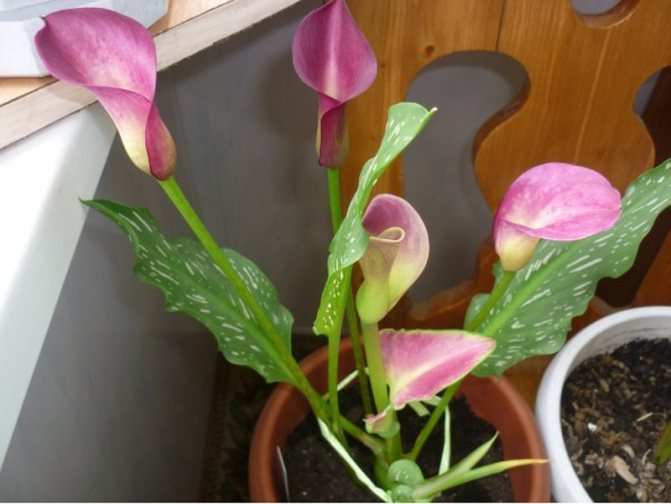

Remann (Calla rehmannii)
- a miniature variety (up to 50 cm in height), distinguished by a bright flower color from pink to deep red. The flowers of red calla lilies served as a starting point for breeding varieties with a variegated color.
Amethyst
- the choice of sophisticated people. Delicate shades of inflorescences intertwine with the aromas of the sea air, creating an atmosphere of comfort and luxury. This flower variety has become an integral part of women of royal blood.
These are not all types of indoor calla lilies, thanks to selection, new varieties appear on the market every year. Bred indoor calla lilies are more and more variegated and sophisticated colors.


